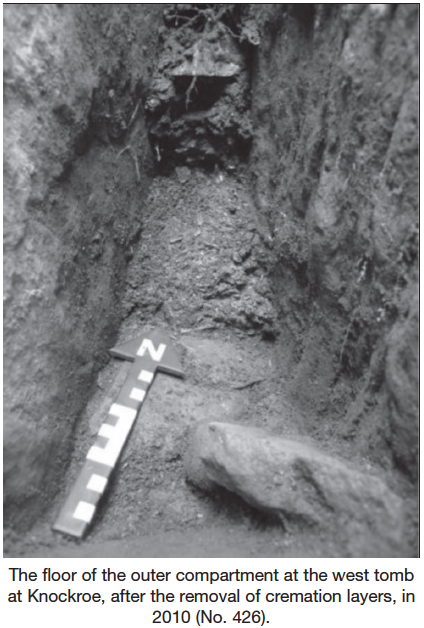2010:426 - KNOCKROE, Kilkenny
County: Kilkenny
Site name: KNOCKROE
Sites and Monuments Record No.: KK034–019001
Licence number: C424; E000554
Author: Muiris O’Sullivan, School of Archaeology, University College
Author/Organisation Address: Belfield, Dublin 4
Site type: Megalithic tomb - passage tomb
Period/Dating: Prehistoric (12700 BC-AD 400)
ITM: E 640811m, N 631318m
Latitude, Longitude (decimal degrees): 52.431830, -7.399853
This passage tomb site, known locally as ‘The Coshel’, occurs on a south-facing slope less than 150m from the Lingaun River, which forms the boundary between counties Kilkenny and Tipperary in the local slate quarries region about 3km upriver from the village of Ahenny. Two tombs featuring solar alignments around midwinter day, 21 December, are located within a single cairn measuring approximately 20m in diameter. There is evidence that the encircling kerb of large boulders may have been added, or at least adjusted, as part of a secondary restructuring. In all more than thirty structural stones at the site bear megalithic art. Funded by grants from the Royal Irish Academy, a series of excavations were conducted during the summers of 1990, 1991, 1994 and 1995 (Excavations 1990, No. 76, Excavations 1991, No. 84, Excavations 1994, No. 140, and Excavations 1995, No. 172; E000554). The site was subsequently taken into state ownership and a conservation plan was commissioned from Margaret Quinland Architects. As part of OPW reinstatement and conservation works at the site, further excavation took place in September 2010.
Previous excavation had established the principal features and contents of the site, and the 2010 season had three specific goals: (1) to collect residual cremated bone that had become visible and vulnerable in the west tomb due to the accidental disturbance of stones by visitors during the past fifteen years, including the west tomb entrance area which had been adjudged too unstable for excavation until secured by OPW personnel; (2) to examine some areas not considered archaeologically rich but vulnerable to minor disturbance from conservation works; and (3) to investigate anomalies in the results of a geophysical survey about 20m west of the site.
Excavations west of the site revealed a cobbled area with some associated artefacts, including fragments of metal and broken honing stones that were not sufficiently diagnostic to establish a date. The cobbling may represent the edge of an industrial or domestic area of broadly medieval date and may be linked with traces of equivalent activity at the eastern edge of the cairn. Small-scale investigations associated with conservation works did not reveal any meaningful evidence.
The most informative archaeological layers were encountered on the floor of the west tomb and around the entrance. In the inner of the three tomb compartments a substantial quantity of cremated bone was recovered from gaps between the orthostats and the floor slab. This was interpreted as the remains of cremation deposits removed in previous seasons. Similar residual deposits were recovered from the middle compartment of the tomb and the remains of one previously undisturbed deposit were also recovered. A significant number of previously undisturbed cremation deposits were encountered in the outer compartment of the tomb, both in the gaps between structural stones and as layers interspersed with small boulders on the paved floor of the compartment. As boulders left undisturbed in 1995 were lifted, further deposits of cremated bone were removed from the platform surface immediately in front of the west tomb. While most cremation deposits inside and outside the tomb were mixed with varying amounts of soil, some pockets of bone were cleaner and distinguishable from the surrounding material. Classic passage tomb artefacts were recovered from the cremation deposits: pendants, beads, tubular spacers, fragments of bone and occasionally antler pins. Post-excavation scrutiny and sieving of the cremated bone produced many additional artefacts, generally of a fragmentary nature. As part of the conservation of the site, two orthostats were temporarily lifted from their sockets on the right side of the west tomb, revealing further concentrations and residual scatters of cremated bone in gaps between structural stones. This indicates that an unknown amount of cremated bone remains unrecorded in hidden gaps amongst the floor stones and orthostats of the tomb.
At the time of writing, the archive from the 2010 season has been processed in UCD and is being integrated with the results from earlier seasons at the site. The Knockroe volume is expected to appear early in 2012 but the references below may be useful.
References
Ó Nuallain, S. and Cody, E. 1987 Passage tombs in the Suir Valley region. JRSAI 117, 69–83.
O’Sullivan, M. 1987 The art of the passage tomb at Knockroe, County Kilkenny. JRSAI 117, 84–95.
O’Sullivan, M. 1993 Recent investigations at Knockroe passage tomb. JRSAI 123, 5–18.
O’Sullivan, M. 1996 A platform to the past: Knockroe passage tomb. Archaeology Ireland 10(2), 11–13.
O’Sullivan, M. 2004 Little and large: comparing Knockroe with Knowth. In Helen Roche et al. (eds), From megaliths to metals: essays in honour of George Eogan. Oxbow Books, 44–50.



